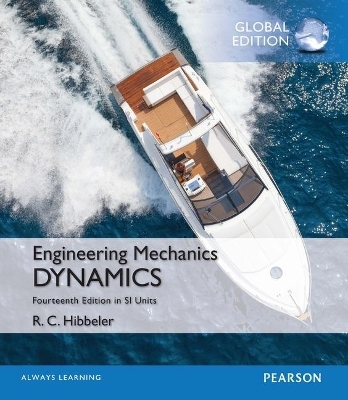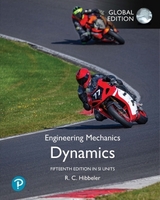
Engineering Mechanics: Dynamics, SI Edition
Pearson Education Limited (Verlag)
978-1-292-08872-3 (ISBN)
- Titel erscheint in neuer Auflage
- Artikel merken
Engineering Mechanics: Dynamics excels in providing a clear and thorough presentation of the theory and application of engineering mechanics. Engineering Mechanics empowers students to succeed by drawing upon Prof. Hibbeler’s everyday classroom experience and his knowledge of how students learn. This text is shaped by the comments and suggestions of hundreds of reviewers in the teaching profession, as well as many of the author’s students.
The 14th Edition includes new Preliminary Problems, which are intended to help students develop conceptual understanding and build problem-solving skills. The text features a large variety of problems from a broad range of engineering disciplines, stressing practical, realistic situations encountered in professional practice, and having varying levels of difficulty.
R. C. Hibbeler graduated from the University of Illinois at Urbana with a BS in Civil Engineering (majoring in Structures) and an MS in Nuclear Engineering. He obtained his PhD in Theoretical and Applied Mechanics from Northwestern University. Professor Hibbeler's professional experience includes postdoctoral work in reactor safety and analysis at Argonne National Laboratory, and structural and stress analysis work at Chicago Bridge and Iron, as well as at Sargent and Lundy in Chicago. He has practiced engineering in Ohio, New York, and Louisiana. Professor Hibbeler currently teaches both civil and mechanical engineering courses at the University of Louisiana - Lafayette. In the past, he has taught at the University of Illinois at Urbana, Youngstown State University, Illinois Institute of Technology, and Union College.
Contents
12 Kinematics of a Particle
12.1 Introduction
12.2 Rectilinear Kinematics: Continuous Motion
12.3 Rectilinear Kinematics: Erratic Motion
12.4 General Curvilinear Motion
12.5 Curvilinear Motion: Rectangular Components
12.6 Motion of a Projectile
12.7 Curvilinear Motion: Normal and Tangential Components
12.8 Curvilinear Motion: Cylindrical Components
12.9 Absolute Dependent Motion Analysis of Two Particles
12.10 Relative-Motion of Two Particles Using Translating Axes
13 Kinetics of a Particle: Force and
Acceleration
13.1 Newton’s Second Law of Motion
13.2 The Equation of Motion
13.3 Equation of Motion for a System
of Particles
13.4 Equations of Motion: Rectangular Coordinates
13.5 Equations of Motion: Normal
and Tangential Coordinates
13.6 Equations of Motion: Cylindrical Coordinates
*13.7 Central-Force Motion and Space Mechanics
14 Kinetics of a Particle: Work and
Energy
14.1 The Work of a Force
14.2 Principle of Work and Energy
14.3 Principle of Work and Energy for a System of Particles
14.4 Power and Efficiency
14.5 Conservative Forces and Potential Energy
14.6 Conservation of Energy
15 Kinetics of a Particle: Impulse
and Momentum
15.1 Principle of Linear Impulse and Momentum
15.2 Principle of Linear Impulse and Momentum for a System of Particles
15.3 Conservation of Linear Momentum for a System of Particles
15.4 Impact
15.5 Angular Momentum
15.6 Relation Between Moment of a Force and Angular Momentum
15.7 Principle of Angular Impulse and Momentum
15.8 Steady Flow of a Fluid Stream
*15.9 Propulsion with Variable Mass
16 Planar Kinematics of a Rigid
Body
16.1 Planar Rigid-Body Motion
16.2 Translation
16.3 Rotation about a Fixed Axis
16.4 Absolute Motion Analysis
16.5 Relative-Motion Analysis: Velocity
16.6 Instantaneous Center of Zero Velocity
16.7 Relative-Motion Analysis: Acceleration
16.8 Relative-Motion Analysis using Rotating Axes
17 Planar Kinetics of a Rigid Body:
Force and Acceleration
17.1 Mass Moment of Inertia
17.2 Planar Kinetic Equations of Motion
17.3 Equations of Motion: Translation
17.4 Equations of Motion: Rotation about a Fixed Axis
17.5 Equations of Motion: General Plane Motion
18 Planar Kinetics of a Rigid Body:
Work and Energy
18.1 Kinetic Energy
18.2 The Work of a Force
18.3 The Work of a Couple Moment
18.4 Principle of Work and Energy
18.5 Conservation of Energy
19 Planar Kinetics of a Rigid Body:
Impulse and Momentum
19.1 Linear and Angular Momentum
19.2 Principle of Impulse and Momentum
19.3 Conservation of Momentum
*19.4 Eccentric Impact
20 Three-Dimensional Kinematics of
a Rigid Body
20.1 Rotation About a Fixed Point
*20.2 The Time Derivative of a Vector Measured from Either a Fixed
or Translating-Rotating System
20.3 General Motion
*20.4 Relative-Motion Analysis Using Translating and Rotating Axes
21 Three-Dimensional Kinetics of a
Rigid Body
*21.1 Moments and Products of Inertia
21.2 Angular Momentum
21.3 Kinetic Energy
*21.4 Equations of Motion
*21.5 Gyroscopic Motion
21.6 Torque-Free Motion
22 Vibrations
*22.1 Undamped Free Vibration
*22.2 Energy Methods
*22.3 Undamped Forced Vibration
*22.4 Viscous Damped Free Vibration
*22.5 Viscous Damped Forced Vibration
*22.6 Electrical Circuit Analogs
A Mathematical Expressions
B Vector Analysis
C The Chain Rule
Fundamental Problem
| Verlagsort | Harlow |
|---|---|
| Sprache | englisch |
| Maße | 205 x 235 mm |
| Gewicht | 1360 g |
| Themenwelt | Schulbuch / Wörterbuch ► Schulbuch / Berufs- und Fachschule |
| Informatik ► Weitere Themen ► CAD-Programme | |
| Technik ► Maschinenbau | |
| ISBN-10 | 1-292-08872-9 / 1292088729 |
| ISBN-13 | 978-1-292-08872-3 / 9781292088723 |
| Zustand | Neuware |
| Haben Sie eine Frage zum Produkt? |
aus dem Bereich



